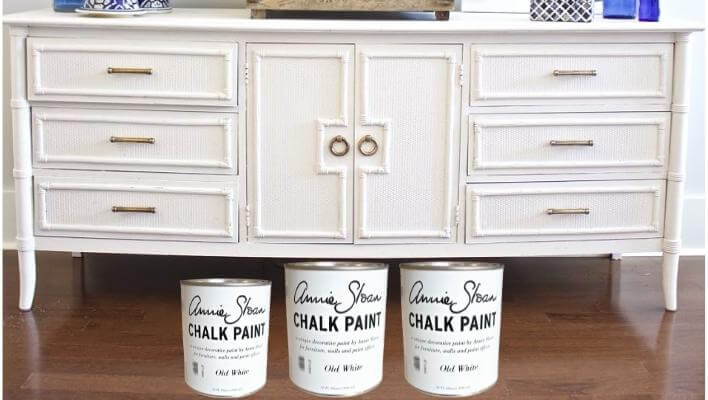In recent years, chalk paint has taken the DIY and home improvement world by storm, owing its popularity to its distinctive matte finish and the ease with which it can be applied. Yet, there comes a time when you might contemplate a change in color or wish to breathe new life into your furniture. In this article, we will delve into the intriguing question: “Can you paint over chalk paint?” The answer, in simple terms, is a resounding YES. However, before embarking on this creative endeavor, there are some essential factors to consider.
Typically, repainting over a previously painted surface isn’t the first choice, but sometimes, exceptional pieces with a pre-existing coat of paint can’t be overlooked. The decision to paint over the chalk paint hinges on the condition of the existing paint. If it’s flaking or displaying signs of poor adhesion, it’s advisable to address chalk paint mistakes first, as applying a new coat over unstable paint may lead to further problems.
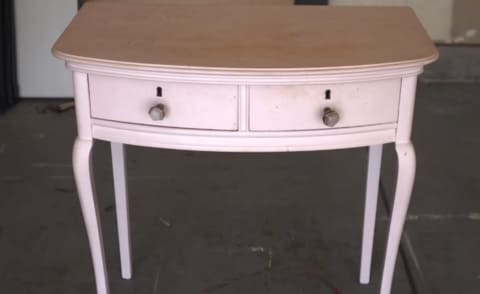
Table of Contents
- Can you paint over chalk paint wax?
- Can you paint over chalk paint without sanding?
- Assess the Condition & Prepare
- Identify the Type of Topcoat:
- Cleaning for Varnish or Poly-type Topcoat:
- Removing Wax Topcoat- How to remove wax from furniture?
- Clean the Surface:
- Primer:
- What paint to use over chalk paint?
- Painting Technique:
- What top coat to use over chalk paint?
- Seal the Paint
- Can you change the color of chalk paint?
- Can you paint over chalk paint with enamel, acrylic paint, latex or semi gloss paint?
- What not to do with chalk paint?
- Conclusion:
- Martina Hitchcock
Can you paint over chalk paint wax?
Yes, I’ve already repainted a vanity that was previously chalk-painted and waxed. Many people have asked me about chalk painting, especially when dealing with a piece that’s already been painted and waxed.
Can you paint over chalk paint without sanding?
Yes, you can paint over chalk paint without sanding, but it’s important to consider the condition of the existing chalk paint. If it’s in good condition without chipping, peeling and no wax on top, you can apply a new coat of chalk paint directly.
However, if the surface is uneven or damaged, light sanding or proper cleaning may be necessary for better adhesion. Use fine-grit sandpaper and be gentle to avoid damaging the underlying wood.
This particular piece had a mirror, which I never finished, sitting in my garage for years. It had a swirly design and was quite dusty.
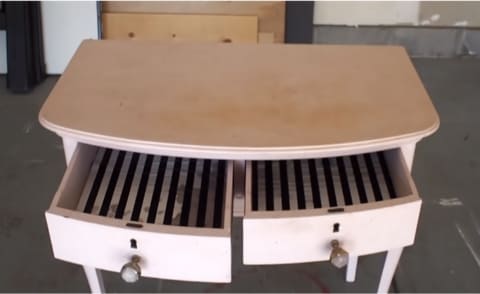
The first step was to remove the hardware, which included some unique handles from Anthropologie. Unfortunately, I didn’t have the keys for the locks, so I had to paint around them. Sanding was needed to remove stubborn glue in some areas.
Assess the Condition & Prepare
The second step is to prepare the surface before painting furniture, especially when dealing with different types of topcoats like wax or varnish, here are the key steps:
Identify the Type of Topcoat:
Determine whether your furniture has a glossy varnish or a wax topcoat by visually inspecting the surface and conducting a scratch test using your fingernail.
Cleaning for Varnish or Poly-type Topcoat:
If your furniture has a glossy topcoat, you can clean it with a product like Fusion’s TSP alternative. Clean the surface thoroughly to eliminate any accumulated dirt and grease. Following the cleaning process, gently sand the piece to create a slightly textured surface, enhancing the adhesion of paint.
Removing Wax Topcoat- How to remove wax from furniture?
Next is removing wax topcoat. In my case, I have to remove the wax using odorless mineral spirits. Ensuring proper paint adherence is important in this process. It’s important to work the mineral spirits into the paint thoroughly to get rid of the wax. Gloves are recommended when handling mineral spirits but I didn’t use them.
So, if your furniture has a wax topcoat, you’ll need to remove the wax before painting. To do this, use a Scotch Brite scrub pad or any scrubbing material and mineral spirits. Scrub the piece of furniture with a mineral spirits-soaked scrub pad, then wipe it off with a rag. This process will remove the wax layer. You can check the detailed process for removing wax from furniture, which I have tested on various projects.
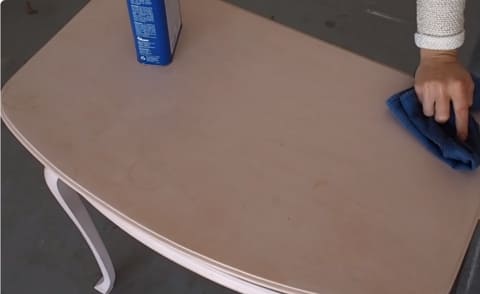
Note: Here I was using Klean Strip odorless mineral spirits because it is a versatile product used to thin oil-based paints, clean brushes, and dissolve wax and grease. It is suitable for a wide range of applications and has been a popular choice among DIY enthusiasts and professionals.
Sometimes I also used Fusion Mineral Paint’s odorless solvent which is specifically designed for use with Fusion Mineral Paint products. It serves as an effective tool for cleaning brushes and thinning paint. I noticed that this solvent was formulated to work seamlessly with Fusion’s paint line, providing consistent results. Moreover, it minimizes the risk of damaging the original chalk paint, making it a safe choice for quick wax removal.
So, you can use any of them.
As you can see scrubbing the furniture with mineral spirits was a simpler process than sanding, making it a more convenient choice for preparing the surface for painting. So, here you got the answer to one of the most commonly asked questions, can you paint over waxed chalk paint on furniture!
Clean the Surface:
After removing the wax or cleaning the varnish, give the furniture a final cleaning using a product like TSP or Krud Kutter to ensure the surface is thoroughly clean and ready for painting.
Primer:
After preparing and cleaning the vanity, applying a primer is a good idea when painting over chalk paint, especially if you’re making a drastic color change. It helps with adhesion and ensures the previous color won’t bleed through.
What paint to use over chalk paint?
You can select water-based latex or acrylic paints that work well over chalk paint. In addition, you can explore the top-quality furniture paint brands.

In my case, I used a mixture of Annie Sloan chalk paint in old white and pure white with some added water (as you can see in the picture above) to make the paint go on smoothly. The first coat doesn’t have to be flawless, so I didn’t stress over complete coverage.
Painting Technique:
Applying paint to surfaces requires precision and care. Begin by using a top-notch brush or a foam roller. I used Annie Sloan chalk paint brush for this purpose as you can see in the picture;
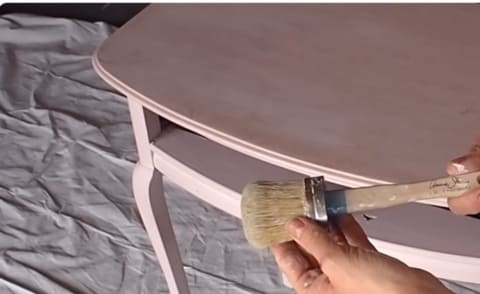
It’s important to start with a thin layer of paint, allowing it to dry before adding more coats. This approach not only enhances adhesion but also prevents the paint from becoming excessively thick. I applied three coats in total to get the desired coverage.
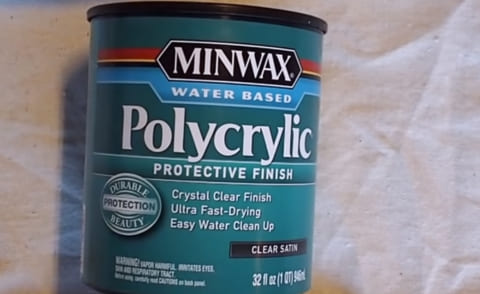
People often asked, What do you cover chalk paint with?
I used a water based polycrylic protective finish for added protection. As per my experience, you can also use other topcoat as well but don’t use oil based polycrylic over chalk paints.
What top coat to use over chalk paint?
| Type of Top Coat | Description |
| Clear Wax | Provides a soft, matte finish and a rustic look. |
| Dark Wax | Used for antiquing and distressing, giving a darker, aged appearance when used with clear wax. |
| Polyurethane | Offers a durable, clear, and protective finish, suitable for high-traffic surfaces. |
| Polycrylic | A water-based alternative to polyurethane that dries clear and provides protection, ideal for surfaces not exposed to water or moisture. |
Seal the Paint
After your new paint has dried completely, consider applying a clear topcoat to protect the finish with. This is especially important for surfaces that will endure significant wear and tear. Learn the step by step process of sealing chalk paint in detail!
The final result was a beautifully repaint vanity, which I was very happy with. Here is the significant difference you can observe before and after painting over chalk paint.
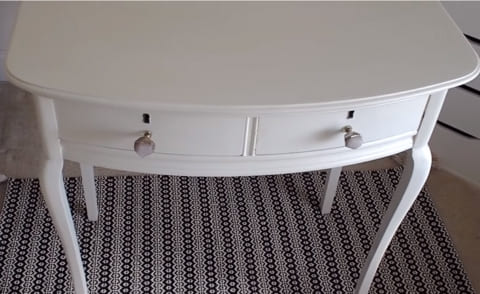
Can you change the color of chalk paint?
Yes, you can change the color of chalk paint by mixing it with other chalk paint colors. Chalk paint is known for its versatility, and you can create custom shades by blending different paint colors together. It’s a great way to achieve the specific color you desire for your project.
Can you paint over chalk paint with enamel, acrylic paint, latex or semi gloss paint?
You can typically paint over chalk paint with various types of paint, including acrylic, enamel, latex, and semi-gloss paints. However, it’s essential to ensure that the surface is well-prepared, and the chalk paint is clean and properly sealed before applying the new paint
What not to do with chalk paint?
What I’ve learned about what not to do with chalk paint is as follows:
| # | What Not to Do with Chalk Paint |
| 1 | Neglect cleaning the surface thoroughly |
| 2 | Skip using a primer when necessary |
| 3 | Apply overly thick layers of chalk paint |
| 4 | Forget to seal the chalk paint for durability |
| 5 | Over-distress the painted surface |
| 6 | Use chalk paint on high-wear surfaces |
| 7 | Paint without proper ventilation |
| 8 | Rush the drying process between coats |
| 9 | Mix different brands of chalk paint |
| 10 | Skip testing on a small area before the full project |
Conclusion:
You can paint over chalk paint. It’s a versatile option for refinishing furniture or walls. When considering repainting, ensure the surface is clean and smooth, and use a good-quality paint for the best results. This process allows you to change colors and give your piece a fresh look without any hassle.

Martina Hitchcock
Martina Hitchcock is a versatile author with expertise in different fields. As a paint sprayer expert, she has in-depth knowledge of paint spraying techniques, tools, and equipment. Martina is also an experienced home remodeler who has worked on various projects, including kitchen and bathroom renovations, flooring installations, and room additions. Her knowledge of home improvement and remodeling is extensive, and she enjoys sharing her insights and tips with readers. You can follow her on Facebook.


